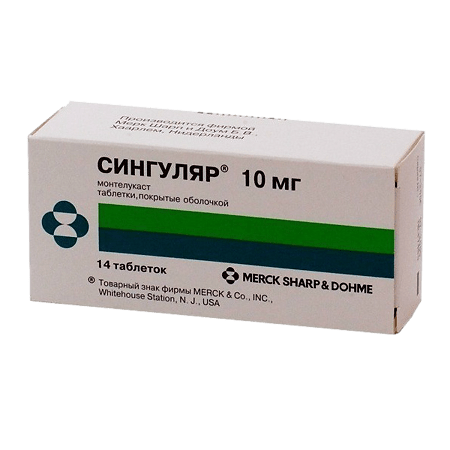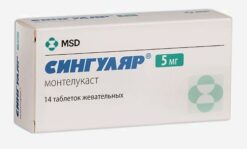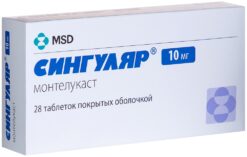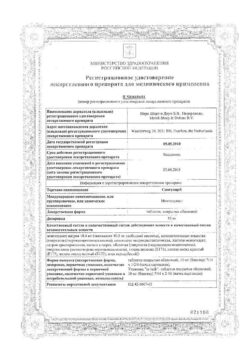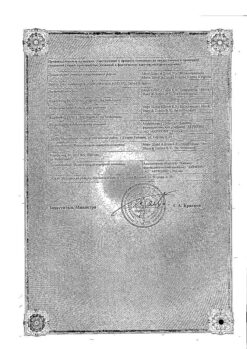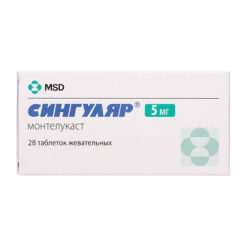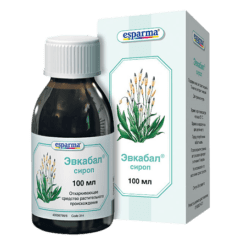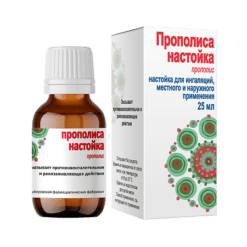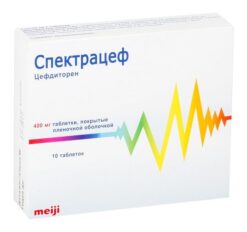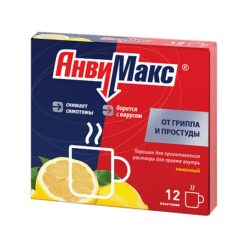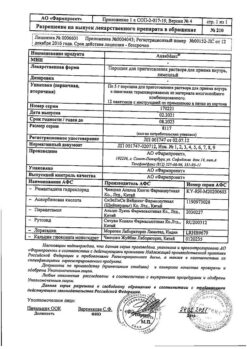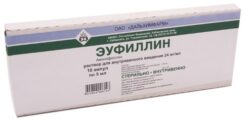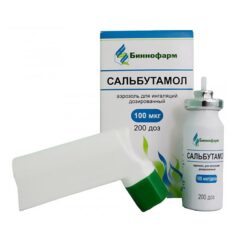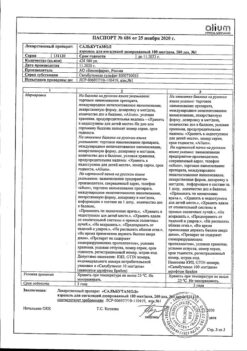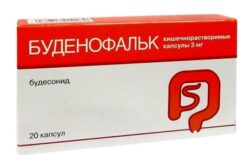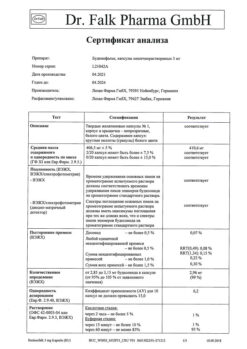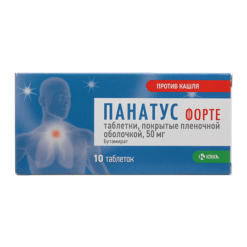No products in the cart.
Singular,10 mg 14 pcs
€37.07 €30.89
Out of stock
(E-mail when Stock is available)
Description
Singulair is an antagonist of leukotriene receptors.
Montelukast inhibits cysteinyl leukotriene receptors of the airway epithelium, showing simultaneously the ability to inhibit bronchospasm caused by inhaled cysteinyl leukotriene LTD4 in patients with bronchial asthma.
The dose of 5 mg is sufficient to relieve LTD4-induced bronchospasm. The use of montelukast in doses exceeding 10 mg/day once/day does not increase the effectiveness of the drug. Montelukast causes bronchodilation within 2 hours after oral administration and may complement bronchodilation induced by beta2-adrenomimetics.
Indications
Indications
Prevention and long-term treatment of bronchial asthma in adults and children aged 6 years and older, including: prevention of daytime and nighttime symptoms of the disease; treatment of bronchial asthma in patients with hypersensitivity to acetylsalicylic acid, prevention of bronchospasm caused by physical activity.
Relief of daytime and nighttime symptoms: seasonal allergic rhinitis in adults and children aged 6 years and older; persistent allergic rhinitis in adults and children aged 6 years and older.
Pharmacological effect
Pharmacological effect
Singulair is a leukotriene receptor antagonist.
Montelukast inhibits cysteinyl leukotriene receptors of the respiratory epithelium, while simultaneously exhibiting the ability to inhibit bronchospasm caused by inhaled cysteinyl leukotriene LTD4 in patients with bronchial asthma.
A dose of 5 mg is sufficient to relieve bronchospasm induced by LTD4. The use of montelukast in doses exceeding 10 mg/day 1 time/day does not increase the effectiveness of the drug. Montelukast causes bronchodilation within 2 hours after oral administration and may be additive to the bronchodilation caused by beta2-agonists.
Special instructions
Special instructions
Singulair is not recommended for the treatment of acute attacks of bronchial asthma. In acute cases of bronchial asthma, patients should be prescribed medications for relief and preventive therapy.
Patients with bronchial asthma are advised to always carry emergency medications (short-acting inhaled beta-agonists).
To relieve an acute attack of bronchial asthma after exercise, a drug is used to relieve the attack, i.e., a short-acting inhaled beta-agonist.
Treatment with Singulair does not guarantee absolute prevention of exacerbations.
During periods of exacerbation of asthma and the need to use emergency medications (short-acting inhaled beta-agonists) to relieve attacks, you should not stop taking Singulair.
Patients with a confirmed allergy to acetylsalicylic acid and other non-steroidal anti-inflammatory drugs should avoid contact with these drugs during treatment with Singulair, since Singulair, while improving respiratory function in patients with allergic bronchial asthma, nevertheless does not prevent bronchoconstriction caused by NSAIDs.
The dose of inhaled glucocorticosteroids used simultaneously with Singulair is reduced gradually under the supervision of a physician. Abrupt replacement of inhaled or oral glucocorticosteroids with Singulair is unacceptable.
In rare cases, a reduction in the dose of systemic corticosteroids in patients receiving concomitant anti-asthmatic drugs, including leukotriene receptor blockers, was accompanied by the appearance of one or more of the following complications: eosinophilia, hemorrhagic rash, worsening of pulmonary symptoms, cardiac complications and/or neuropathy, sometimes diagnosed as Churg-Strauss syndrome (systemic eosinophilic vasculitis). Although the cause-and-effect relationship of these side effects with treatment with leukotriene receptor antagonists has not been established, caution should be exercised when reducing the dose of systemic corticosteroids during treatment with Singulair, and appropriate monitoring of the patient should be provided.
Patients with phenylketonuria should be informed that Singulair contains aspartame in the amount of 1.2 mg per chewable tablet.
No age-related differences in the efficacy and safety profile of Singulair were identified.
Impact on the ability to drive vehicles and operate machinery:
There are no facts indicating that taking Singulair affects the ability to drive a car or operate moving machinery.
Active ingredient
Active ingredient
Montelukast
Composition
Composition
1 film-coated tablet contains:
Montelukast 10 mg.
Excipients:
Microcrystalline cellulose;
Lactose;
Croscarmellose sodium;
Hyprolose;
Magnesium stearate.
Shell composition:
Hyprolose;
Hypromellose;
Titanium dioxide;
Iron oxide red and iron oxide yellow dyes;
Carnauba wax.
Pregnancy
Pregnancy
Singulair should be used during pregnancy and lactation only in cases where the expected benefit to the mother outweighs the potential risk to the fetus or child.
Contraindications
Contraindications
Hypersensitivity to the components of the drug.
With caution: pregnancy, breastfeeding.
Side Effects
Side Effects
Allergic reactions: anaphylaxis, angioedema, rash, itching, urticaria; very rarely – eosinophilic infiltration of the liver.
From the central nervous system: unusual vivid dreams, hallucinations, drowsiness, irritability, agitation (including aggressive behavior), fatigue, headache, suicidal thoughts and suicidal behavior (suicidality), insomnia, paresthesia/hypoesthesia; very rarely – seizures.
From the digestive system: nausea, vomiting, diarrhea, abdominal pain.
From the musculoskeletal system: arthralgia, myalgia, including muscle cramps.
Dermatological reactions: erythema nodosum, tendency to the formation of subcutaneous hemorrhages.
Other: tendency to increased bleeding, subcutaneous hemorrhages, palpitations, swelling.
In general, Singulair® was well tolerated. Side effects are usually mild and usually do not require discontinuation of treatment. The overall incidence of side effects reported with Singulair is comparable to that observed with placebo.
Interaction
Interaction
Singulair can be prescribed together with other drugs that are usually used for the prevention and long-term treatment of bronchial asthma and/or the treatment of allergic rhinitis.
The recommended therapeutic dose of montelukast did not have a clinically significant effect on the pharmacokinetics of the following drugs: theophylline, prednisone, prednisolone, oral contraceptives (ethinyl estradiol/norethinodrel 35/1), terfenadine, digoxin and warfarin.
The AUC value of montelukast is reduced by simultaneous administration of phenobarbital by approximately 40%, which does not require changes in the dosing regimen of Singulair.
In vitro studies have shown that montelukast inhibits the cytochrome CYP2C8 isoenzyme system. However, when studying the drug-drug interaction in vivo of montelukast and rosiglitazone (metabolized with the participation of the CYP 2C8 isoenzyme of the cytochrome system), there was no confirmation of inhibition of the CYP 2C8 isoenzyme by montelukast. Thus, in clinical practice, the effect of montelukast on the CYP 2C8-mediated metabolism of a number of drugs, including paclitaxel, rosiglitazone, repaglinide, etc. is not expected.
Combination treatment with bronchodilators: Singulair is a reasonable addition to bronchodilator monotherapy if the latter do not provide adequate control of bronchial asthma. Once a therapeutic effect has been achieved (usually after the first dose) from treatment with Singulair, a gradual reduction in the dose of bronchodilators can begin.
Combined treatment with inhaled glucocorticosteroids: Treatment with Singulair provides an additional therapeutic effect for patients using inhaled glucocorticosteroids. Once stabilization is achieved, you can begin to reduce the dose of the corticosteroid – gradually and under the supervision of a physician. In some cases, complete withdrawal of inhaled glucocorticosteroids is acceptable, but abrupt replacement of inhaled corticosteroids with Singulair is not recommended.
Overdose
Overdose
Symptoms: symptoms of Singulair overdose in patients with chronic bronchial asthma when used at a dose exceeding 200 mg/day for 22 weeks and at a dose of 900 mg/day for 1 week have not been identified.
There are reports of acute overdose of montelukast in children (at a dose of at least 150 mg/day). Clinical and laboratory data indicate that the safety profile of Singulair in children corresponds to the safety profile in adults and elderly patients. The most common adverse events were thirst, drowsiness, mydriasis, hyperkinesis and abdominal pain.
Treatment: symptomatic therapy.
There are no data on the possibility of removing montelukast by peritoneal dialysis or hemodialysis.
Storage conditions
Storage conditions
In a dry place, protected from light, at a temperature not exceeding 30 °C
Shelf life
Shelf life
3 years.
Manufacturer
Manufacturer
Organon Pharma (UK) Limited, UK
Additional information
| Shelf life | 3 years. |
|---|---|
| Conditions of storage | In a dry, light-protected place at a temperature not exceeding 30 °C |
| Manufacturer | Organon Pharma (UK) Limited, United Kingdom |
| Medication form | pills |
| Brand | Organon Pharma (UK) Limited |
Other forms…
Related products
Buy Singular,10 mg 14 pcs with delivery to USA, UK, Europe and over 120 other countries.

